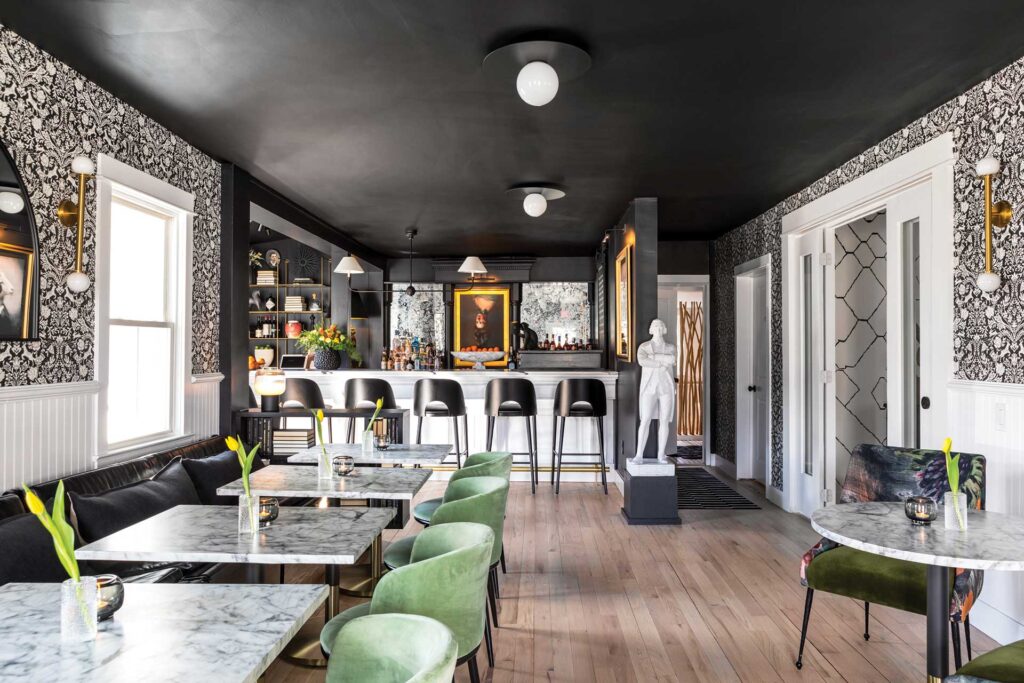When DSGNER’s Eduardo Rodríguez and Herman Vega reimagined this 150-year-old inn, they obliterated the prevailing Catskills interior aesthetic.
By Simon Murray
Photography by Winona Barton-Ballentine
I’ve lived in the Hudson Valley long enough to know that there are two prevailing design aesthetics. The first we’ll call the “general store,” with its rustic wood paneling, folksy wallpaper and decidedly antiquated furniture (“this is my grandmother’s side table”). Businesses with this décor feel arrested in time, as if modernity in its tomorrow-bound haste up and left streaming toward the horizon, leaving these poor charming places to lapse into dust. Which is to say, the general store aesthetic is less a choice and more a series of hardships calcified into a fossil-like existence. But boy, do they have personality to spare.
The other prevailing aesthetic is austere minimalism. Sleek, shorn and brittle like bone—or smooth and everlasting like titanium—these ultra-modern, glassy interiors call to mind Frank Lloyd Wright and Ludwig Mies van der Rohe. They also feel more than a little soulless.
These polarities are so at arms with each other, you’d be a little daft to think that any design could incorporate both. Except, that’s exactly what I’m suggesting. A much-needed interior redesign of the Central House in Germantown by the boutique studio DSGNER, headed by Eduardo Rodríguez, puts forth a more daring, 21st-century aesthetic that feels like a connective piece of tissue between the past and present.
“We took elements from both in order to tell a cohesive story, reflected in each of the spaces we redesigned,” Rodríguez tells me. He also couldn’t have found a more fitting project for his concept of stylistic layering. Established in 1876, the Central House has served as brothel, speakeasy, stagecoach house and various restaurants, before ultimately being converted into an inn. When it was acquired by Julia Carr and Leslie Carr-Avalos last fall, the Red Hook-raised sisters knew they needed the right megawatt talent to bring this project to life. Rodríguez and his business partner and husband, Herman Vega, the former award-winning creative director of People en Español who now runs his own branding and creative direction business, were all too happy to oblige.
The process began last August with an investigative once-over of both the space and the owners. “Eduardo and Herman were getting to know us and our personalities, as well as getting a deep feel for the space to see what would work here,” says Carr-Avalos, who brings the anima of her San Francisco restaurant, Universal Café, to the Germantown inn in both name and spirit. “They were very open to our ideas and thoughts and yet offered gentle guidance when we may not have understood the big picture.”
The design work began on Thanksgiving week, and about four months later, “We see ourselves woven into the entire place,” Carr says laughing. “Central House’s design is marked with a sense of humor, whimsy and playfulness that we both treasure.”
Though the hotel can be considered designed practically within an inch of itself, there’s been no sense of comfort sacrificed. Guests reportedly feel transported yet at home thanks to the curated history alive in every space—from the accommodations to the bar and restaurant. It’s all sort of magical.
Another word for it would be timeless. Or beautiful. Or unexpected. Or, best yet, perfect.
















Comments are closed.